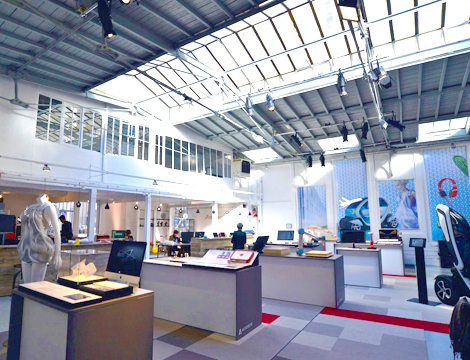
Autodesk’s Paris gallery is a showcase for its customers work, stretching from architectural structures to Maker projects
With Autodesk’s first European pop-up gallery in the heart of Paris attracting over 1,500 visits in the first four days, the company is now considering other cities for in which to hold the experience.
The software giant already has US-based engagement centres where it showcases customer work, such as at its headquarters in downtown San Francisco, and the Gallery within its fabrication Lab on the city’s Pier 9, but for the first time it has taken its outreach further.
Its first pop-up in the heart of Paris will run for three weeks; the space including a 3D print zone and Fablab, artist in residency, evening events and customer work from architecture, product design, fashion, 3D printing and laser scanning.
Located at the Gallerie Nikki Diana Marquardt on the edge of the Marais area, the venue is central to attract both designers and the passing public for free entry.
Keeping obvious branding to an absolute minimum, the space offers a combination of interactive and static displays, as well as its latest 3D Printing project Spark, and its open source Ember 3D Printer.
Some of the Paris exhibits:

Hacked 3D printer tattoo gun
One of the unusual items on display is a hacked Makerbot 3D printer that has been reappropriated to be an automated tattoo gun.
Replacing the extruder head with a needle, the device rather eerily sits in the corner with a dismembered fake arm, which already has some doodles on it. Apparently the device and concept took just 8 hours for students to make and a volunteer has already been ‘inked’ by the device.
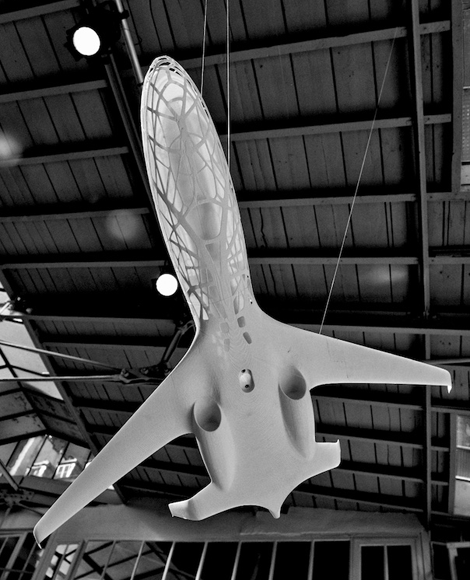
Airbus Concept Plane
Looking at what planes will look like in 2050, Airbus has set out to revolutionise the structural design of aircraft.
Stretching current engineering knowledge, the concept plane, beautifully 3D printed and flying over the gallery, features ultra-long and slim wings, semi-embedded engines, a U-shaped tail, and lightweight body all help to improve environmental performance.
The bionic structural lattice was optimised by computer to provide the maximum strength for the greatest amount of natural light through a bio-polymer membrane, eliminating the need for windows. Certainly not a design for those who suffer vertigo.
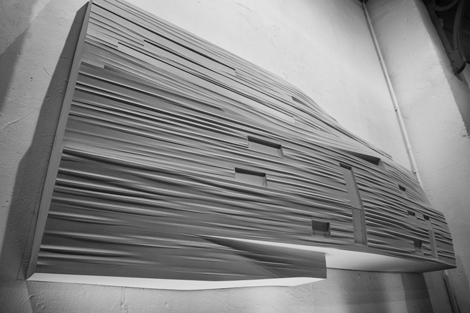
San Francisco Museum of Modern Art – Snøhetta
The highly impressive new San Francisco Museum of Modern Art expansion building, which takes up a whole wall with an impressive façade relief specially created to show the design’s styling and innovative fabrication techniques.
The complex design by the Norwegian/ US practice, Snøhetta, was created by cutting huge panels in foam by computer controlled wire.
Using these foam patterns as molds, fiberglass castings were made for the façade construction. These were then treated with a special coating and were shipped to site using the original foam molds as protection. The net result was a very light and expressive cladding system
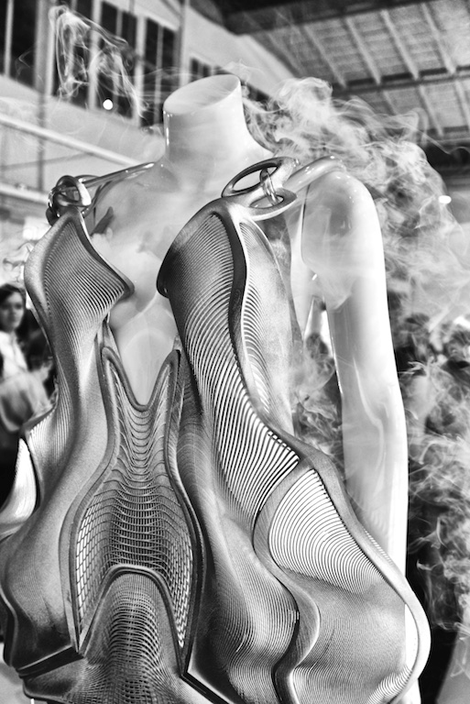
Smoke Dress – Anouk Wipprecht
Drawing a lot of attention, Anouk Wipprecht’s dress is 3D printed and happily slowly cycles it’s built-in LED lighting.
However, should you stand too close to the wearer invading their personal space, the built in sensors trigger the lights to flash, warning the interloper to move away.
If this fail to get a reaction, the dress then emits a cloud of dry ice smoke from a neckless/ tube! This is either for the wearer to escape into the fog or to irritate the ‘close talker’.
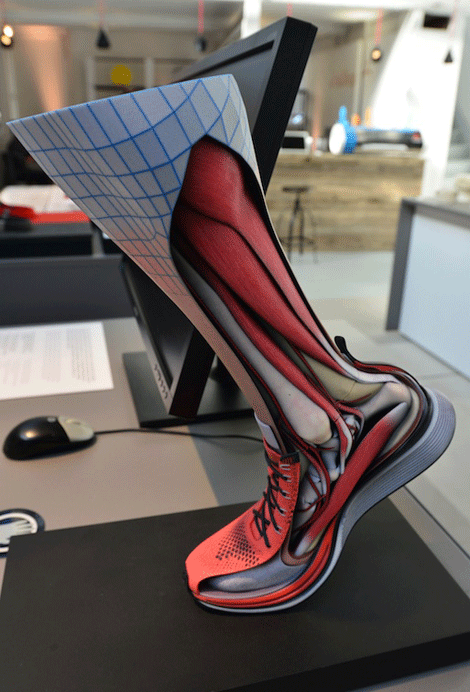
Nike analysis and 3D Printed trainers
Apparel is getting into 3D printing big time and here Nike seems to be leading the charge.
Nike is getting superstar athletes to undergo motion capture in their typical sports The movement is computerized and simulation and analysis done on the pressure and stresses in their footing.
This information is then used to create custom shoes for individual athletes, tuned to the way they move.
Nike has also started 3D printing shoes and 3D printing cleats into the soles of football boots for optimum traction on the turf. Using Selective Laser Sintering with a proprietary material, Nike has created a fully functional plate and traction system in a fraction of the traditional timeframe and at a fraction of the weight.
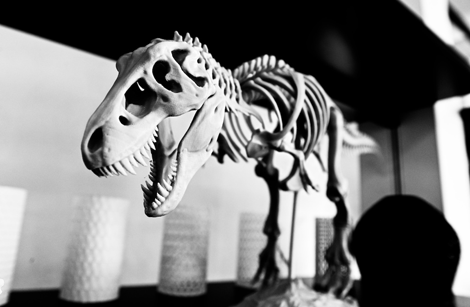
Maker incubator
Autodesk also recruited local ‘maker’ shops and innovation incubators to support the gallery offering. In Paris, Bertier Buyt of ‘LeFabShop’, and Gary Cige of Usine.io were on hand to meet prospective designers and start-ups and offer advice on 3D printing, fabrication and finding work spaces.
While the noise on the Internet seems to identify the ‘Maker’ revolution as a mainly American movement, it was clear from our visit to Paris that there are many people with a product in mind that want to bring their ideas to market.
The Paris gallery featured a whole wall of 8 Makerbot Replicator 2 printers (http://www.makerbot.com), an Mcor Iris and a Roland Versa Studio printer/cutter. There’s a display space for many previously printed parts and some kits for visiting children to assemble.
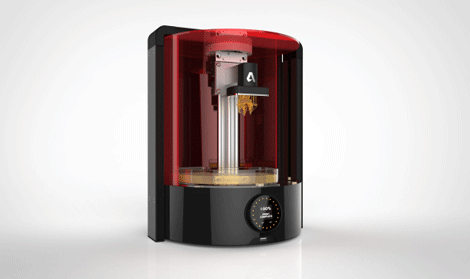
Project Spark
The gallery also served as the venue for the first hands-on with the company’s 3D Printer, named Ember. Autodesk had the machine designed in the UK and the initial batch was hand made at Autodesk’s Pier 9 facility in San Francisco. It’s expected that at some point in time, fabrication will be moved to a provider with great capacity. Autodesk is using the experience to use as a test bed for its own 3D printer software development and to promote its brand.
With the success of the gallery Autodesk is now considering other countries for a pop-up gallery experience. Countries currently in discussion are Germany, Italy and the UK.
Many of the projects on display were the work of local clients and it was not a simple transplantation of artifacts from the San Francisco Gallery. So we would assume that future gallery pop-ups would also reflect some work by local nationals, meaning the gallery will evolve and be refreshed with each incarnation.
Autodesk is in every respect acting like a cool start-up, albeit it a start-up that turns over a couple of billion dollars every year. With the gallery experience providing a great snapshot of the innovations currently shaping the design world from small scale jewellery to giant infrastructure projects, it’s inspiring and educational with no hard sell as you wander about the exhibits.
It’s a shame the pop-up element means that it will never be in town for long, although it’s easy to wonder what will be the next step for Autodesk along these lines.






